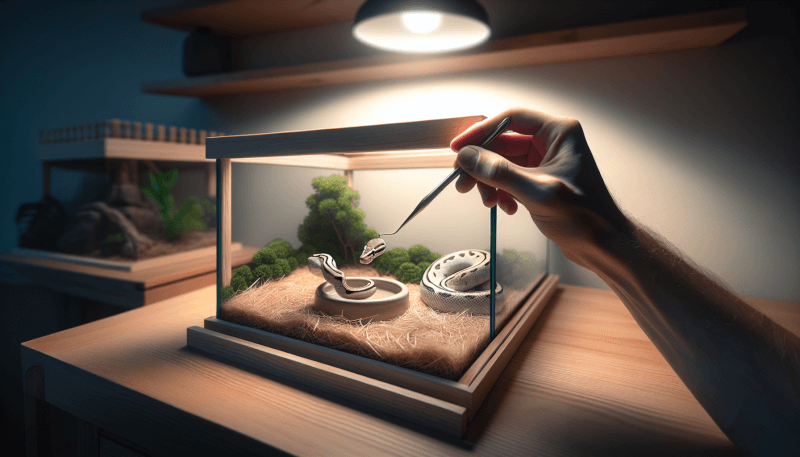Setting up a safe feeding area for your snake is crucial to ensure its well-being and minimize potential risks. By creating an environment that is both secure and comfortable, you can guarantee a stress-free feeding experience for your slithery companion. With proper attention to details such as enclosure size, temperature, and handling techniques, you can establish a feeding space that promotes your snake’s health and safety while providing you with peace of mind.
Choosing the Right Enclosure
Size of the enclosure
When it comes to choosing the right enclosure for your snake’s feeding area, size matters. Snakes need enough space to move around and stretch out comfortably, especially when feeding. A cramped enclosure can lead to stress and may even affect their appetite. As a general rule of thumb, the enclosure should be at least as long as the snake’s body and wide enough for it to turn around easily. If you plan on feeding larger prey items, consider getting a larger enclosure to accommodate the additional space needed.
Material of the enclosure
The material of the enclosure is another important factor to consider. Snakes are known for their ability to escape from enclosures, so it is crucial to choose a material that is secure and durable. Glass enclosures are commonly used because they provide a clear view of your snake during feeding, allowing you to monitor their behavior. However, keep in mind that glass can be easily broken, so be cautious when handling and be sure to secure the enclosure properly. Alternatively, you can opt for plastic or PVC enclosures, which are lightweight, easy to clean, and provide excellent security.
Security features of the enclosure
Ensuring the security of the enclosure is essential to prevent any potential escapes or accidents during feeding. Look for enclosures that have secure latches or locks to keep the enclosure tightly sealed. Additionally, consider using clip-on or sliding tops to further reinforce the enclosure’s security. Snakes are curious creatures and can be quite adept at finding ways to escape, so investing in a well-designed enclosure with sturdy security features will give you peace of mind and keep your snake safe.
Selecting the Right Feeding Equipment
Feeding dishes
Feeding dishes are an essential part of your snake’s feeding area. They provide a designated space for your snake to consume its prey and help prevent any mess or contamination within the enclosure. Choose shallow, easy-to-clean dishes that are large enough to accommodate the size of your snake’s prey. Stainless steel or ceramic dishes are ideal options as they are hygienic, durable, and resistant to tipping over.
Tweezers or tongs
Using tweezers or tongs to handle and offer food to your snake is a popular method for both convenience and safety. By using these tools, you can maintain a safe distance from your snake’s feeding area and minimize the risk of accidental bites. Make sure to use long-handled tweezers or tongs to avoid getting too close to your snake’s head during the feeding process. This method allows you to have better control over the placement of the prey without any direct contact with your snake.
Separate feeding enclosure
Consider using a separate feeding enclosure when offering food to your snake. This can prevent any substrate or bedding from being accidentally ingested along with the prey, reducing the risk of impaction. A separate feeding enclosure also helps to create a designated feeding area for your snake, promoting a focused and stress-free feeding experience. It is important to ensure that the feeding enclosure is secure and properly set up, replicating the conditions of the snake’s primary enclosure as closely as possible.

Creating a Comfortable Feeding Environment
Sufficient lighting and temperature
Proper lighting and temperature are crucial in creating a comfortable feeding environment for your snake. Snakes are ectothermic creatures, meaning they rely on external sources of heat to regulate their body temperature. Ensure that the temperature in the feeding area is within the species-specific recommended range. Use a thermometer to monitor and maintain the appropriate temperature.
Additionally, snakes are sensitive to light and require a proper day and night cycle. Provide a suitable lighting source that mimics natural daylight patterns, including both UVB and UVA light if necessary, to support their overall health and well-being. Avoid feeding your snake in complete darkness as it can be disorienting and potentially stress-inducing for them.
Bedding and substrate
Choose the right bedding or substrate for your snake’s feeding area to ensure their comfort and minimize the risk of ingestion or impaction. Avoid using loose substrates such as sand, gravel, or wood shavings, as they can be easily ingested during feeding and may pose a health risk. Instead, opt for safe alternatives such as reptile carpet, paper towels, or newspaper. These options are easy to clean and provide a hygienic surface for feeding.
Hiding spots or caves
Snakes are naturally solitary and secretive creatures that require hiding spots or caves to feel secure. Providing hiding spots in the feeding area can alleviate stress and enable your snake to eat in privacy. Consider using specially designed reptile hides or create DIY hiding spots using sturdy materials such as rocks, logs, or even PVC pipes. These hiding spots should be large enough for your snake to comfortably fit inside and should be strategically placed to allow easy access during feeding.
Establishing Feeding Schedule and Routine
Feeding frequency and portion sizes
Establishing a proper feeding schedule and portion sizes is essential for maintaining your snake’s health and avoiding overfeeding or underfeeding. The frequency of feedings largely depends on the age, species, and size of your snake. Research the specific dietary requirements of your snake species and consult with a reptile veterinarian for guidance. Young snakes typically require more frequent feedings compared to adult snakes.
Portion sizes should be appropriate for the size of your snake, ensuring that the prey is not too large or too small. Overly large prey items can lead to regurgitation or digestive issues, while prey that is too small may not provide adequate nutrition.
Consistency in feeding times
Snakes thrive on routine, and establishing a consistent feeding schedule can help reduce stress and promote a healthy appetite. Aim to feed your snake at the same time each feeding day to create a predictable routine. Consistency in feeding times also ensures that your snake is properly prepared for feeding, both mentally and physically. Avoid feeding your snake immediately after handling or during shedding periods as they may be less interested in food or more prone to stress.
Avoiding disturbances during feeding
To ensure a stress-free feeding experience, it is crucial to minimize disturbances during feeding. Snakes can be sensitive to sudden movements, loud noises, or vibrations that may startle or distract them. Choose a quiet and calm location for feeding, away from busy areas of your home. Inform other household members about the feeding schedule to prevent any interruptions. Remember to be patient and allow your snake uninterrupted time to consume its prey.

Preparing and Offering the Correct Food
Identifying suitable prey size
Choosing the appropriate prey size is crucial for your snake’s health and digestion. Prey items should be similar in size to the girth of your snake at its widest point to ensure easy swallowing. Avoid offering prey that is too large, as it can cause choking or impaction. Conversely, prey that is too small may not provide sufficient nutrition for your snake. It is important to regularly reassess your snake’s size and adjust the prey size accordingly.
Proper thawing and warming of frozen prey
If you are feeding your snake frozen prey, it is crucial to properly thaw and warm it before offering it to your snake. Thaw the prey in the refrigerator until completely defrosted, ensuring that it is not heated using a microwave or hot water, as this can result in uneven warming and potential bacterial growth. Once thawed, warm the prey to approximately the same temperature as your snake’s body by placing it in warm water or using a heat mat. This ensures that the prey is at an ideal temperature for digestion and minimizes the risk of digestive issues.
Avoiding inappropriate food items
It is essential to offer your snake appropriate food items that align with their natural dietary preferences and nutritional needs. Snakes are carnivorous creatures and primarily eat rodents, birds, or other small animals depending on their species. Avoid offering live prey unless it is necessary, as live prey can potentially injure your snake during feeding. Furthermore, avoid feeding your snake wild-caught prey as it may introduce parasites or diseases. Instead, opt for commercially bred and properly euthanized prey that is nutritionally balanced for your snake.
Ensuring Hygiene and Safety Measures
Cleaning and disinfecting the feeding area
Maintaining a clean and hygienic feeding area is crucial for your snake’s health and preventing the spread of diseases. Regularly clean and disinfect the feeding dishes, substrate, and any other materials in the feeding area that come into contact with the prey or your snake. Use reptile-safe disinfectants and thoroughly rinse all surfaces to remove any residue before allowing your snake access to the feeding area again.
Avoiding cross-contamination
To prevent cross-contamination and potential illness, it is important to handle feeders and feeding equipment separately from other household items. Avoid using the same tongs or tweezers for feeding your snake as you would for other purposes. Designate specific feeding equipment that is used exclusively for your snake and store it separately from other household utensils. Keep different species of snakes and their corresponding feeding equipment separate to prevent any potential cross-contamination.
Handling and disposing of uneaten prey
If your snake does not consume the entire prey item during feeding, it is important to handle and dispose of it properly to maintain cleanliness and prevent any potential hazards. Use the feeding equipment to safely remove any uneaten prey, taking care not to disturb or stress your snake. Dispose of any uneaten prey in a sealed bag and promptly discard it in an appropriate trash receptacle outside. Do not leave uneaten prey in the enclosure, as it can lead to bacterial growth or attract pests.

Monitoring and Observing Feeding Behavior
Watching for signs of aggression
During feeding, it is important to be observant and watch for any signs of aggression from your snake. Some snakes may exhibit defensive behavior when approached or when their prey is introduced. Be cautious and attentive to any sudden changes in body posture, hissing, or striking behavior. If your snake displays aggression during feeding, it may be best to provide the prey item using feeding tongs or seek professional guidance to address the behavior.
Monitoring feeding response
Observing your snake’s feeding response is crucial for ensuring that it is consuming its prey properly. A healthy snake will actively engage with its prey, striking and constricting it before swallowing. Monitor your snake during feeding to ensure that it is exhibiting normal feeding behavior. If you notice any prolonged hesitation, regurgitation, or lack of interest in food, it may indicate underlying health issues that require veterinary attention.
Recognizing abnormal feeding behavior
Being familiar with your snake’s normal feeding behavior will enable you to recognize any abnormal signs or changes. Abnormal feeding behavior can include refusal to eat, excessive aggression, regurgitation, or a sudden loss of appetite. These may be indications of health issues such as stress, illness, or improper husbandry. If you notice any concerning changes in your snake’s feeding behavior, reach out to a reptile veterinarian for a comprehensive examination and advice.
Seeking Veterinary Guidance
Consulting a reptile veterinarian
When it comes to your snake’s health and feeding, it is always recommended to consult a reptile veterinarian for professional guidance and support. A reptile veterinarian will have the knowledge and expertise to assess your snake’s overall health, evaluate its dietary requirements, and address any specific feeding concerns. Regular check-ups and consultations with a reptile veterinarian can help prevent and address any potential health issues before they become significant problems.
Identifying signs of feeding issues
Sometimes, snakes may have feeding issues or challenges that require veterinary intervention. If your snake consistently refuses to eat, experiences sudden weight loss, or displays abnormal feeding behaviors, it is crucial to seek veterinary guidance. These signs may indicate underlying health issues, metabolic disorders, or difficulties processing food. A reptile veterinarian can perform diagnostic tests to identify any underlying causes and recommend appropriate treatment options.
Addressing health concerns
Feeding issues can often be linked to broader health concerns in snakes. In addition to seeking veterinary guidance, it is important to address any health concerns that may be impacting your snake’s feeding. This may involve making adjustments to their enclosure, environmental conditions, or implementing a comprehensive treatment plan prescribed by a reptile veterinarian. By addressing any underlying health concerns, you can help ensure optimal feeding practices and overall well-being for your snake.

Educating Yourself about Snake Nutrition
Understanding dietary requirements
Educating yourself about snake nutrition is essential for providing a well-balanced diet that meets your snake’s specific dietary requirements. Different snake species have different nutritional needs, and understanding these requirements is crucial for their overall health and longevity. Research reliable sources such as reputable books, scientific articles, or consult with a reptile veterinarian to gain a comprehensive understanding of the specific dietary needs of your snake species.
Researching appropriate prey species
Snakes have evolved to eat a wide variety of prey species, and it is important to research and understand what constitutes appropriate prey for your snake. Different snake species have different natural diets, ranging from rodents to birds to amphibians. Research the preferred prey species for your snake and ensure that you are providing a diverse and balanced diet that includes the necessary nutrients and vitamins.
Balancing nutritional needs
Providing a balanced diet is crucial for meeting your snake’s nutritional needs. In captivity, it can be challenging to replicate the exact nutritional composition of a snake’s natural diet. To ensure a balanced diet, consider offering a variety of prey items that provide different nutritional profiles. This can be achieved by rotating between different prey species, sizes, and even feeder insects if appropriate. Balancing nutritional needs helps prevent nutritional deficiencies and promotes overall health and vitality for your snake.
Handling and Safety Precautions
Training your snake to associate handling with positive experiences
Handling your snake can be an enjoyable and interactive experience for both you and your pet. However, it is important to establish a positive association between handling and pleasant experiences for your snake. Gradually introduce handling sessions when your snake is calm and receptive, and reward them with a treat or a positive interaction afterward. Over time, your snake will associate handling with positive experiences and be more comfortable during handling sessions.
Taking necessary precautions when handling during feeding
Snakes can become defensive or agitated during and after feeding, especially if they feel threatened or disturbed. It is crucial to take necessary precautions when handling your snake during feeding periods. Avoid handling your snake immediately before or after feeding to prevent any potential stress or aggression. Allow your snake enough time to fully digest its prey before handling, ensuring that it is in a calm and relaxed state.
Safety tips for children and other household members
If you have children or other household members who may interact with your snake, it is important to educate them on proper handling techniques and safety precautions. Teach children to approach your snake gently and avoid sudden movements or loud noises that may startle the snake. Always supervise interactions between children and snakes, and never leave them unsupervised. Educating your family members about snake behavior, potential risks, and appropriate handling practices can help ensure a safe and enjoyable experience for everyone involved.
In conclusion, setting up a safe feeding area for your snake is essential for their overall well-being and health. By carefully considering the size and material of the enclosure, selecting the right feeding equipment, creating a comfortable environment, establishing a feeding schedule, providing the correct food, ensuring hygiene and safety measures, monitoring feeding behavior, seeking veterinary guidance, educating yourself about snake nutrition, and practicing proper handling and safety precautions, you can create a safe and optimal feeding environment for your snake. Remember, understanding and meeting your snake’s specific needs will contribute to their overall health and happiness as a cherished pet.



